If you're a Big Cartel user looking to elevate your online store, migrating to Shopify might be the next logical step.
By learning how to migrate from Big Cartel to Shopify, you can unlock a plethora of advanced features, scalability, and a robust ecommerce platform.
In this guide, we'll provide you with a comprehensive tutorial on how to migrate from Big Cartel to Shopify, ensuring a seamless transition and empowering you to maximize the potential of your new online store.
Let's get started!
Why Migrate from Big Cartel to Shopify?
While Big Cartel and Shopify both have their advantages as ecommerce platforms, some features from Shopify make it a no-brainer to move from Big Cartel.
There are several compelling reasons why you should consider migrating from Big Cartel to Shopify. Here are some key advantages that Shopify offers over Big Cartel:
- Features and Functionality: Shopify offers a wider range of features and functionality compared to Big Cartel. Shopify provides advanced inventory management, integrated blogging, customizable themes, and extensive payment options. Big Cartel, on the other hand, has a simpler feature set more suitable for smaller stores with basic needs.
- Scalability: Shopify is known for its scalability and ability to handle businesses of all sizes. It can accommodate high volumes of traffic and a large number of products. Big Cartel, on the other hand, is better suited for smaller stores with limited product offerings and lower traffic levels.
- App Store: Shopify has an extensive app store with thousands of apps and integrations that allow you to extend the functionality of your store. Big Cartel has a more limited selection of apps, which may hinder your ability to customize and enhance your store.
- Support: Shopify provides 24/7 customer support through multiple channels, including live chat, email, and phone. Big Cartel offers support through email only and has more limited support hours.
- Multichannel Selling: Shopify enables you to sell your products not only through your online store but also through various channels like social media platforms (Facebook, Instagram), marketplaces (Amazon, eBay), and in-person with their point-of-sale (POS) system. Big Cartel primarily focuses on online store functionality and lacks built-in multichannel selling capabilities.
- Design and Customization: Shopify offers a more extensive range of customizable themes and templates, allowing you to create a visually appealing and unique online store. Big Cartel has a limited selection of themes, which may result in less flexibility in terms of design customization.
Considering these differences, Shopify is often a better choice for businesses looking for advanced features, scalability, and a wider range of customization options.
On the other hand, if you run a smaller store with basic needs, we recommend sticking with Big Cartel, since it’s easier to manage in that situation, and Big Cartel has lower pricing.
With that said, let’s explore the steps you need to take to migrate from Big Cartel to Shopify.
How to Migrate from Big Cartel to Shopify Using an App
There’s no completely automated method to migrate from Big Cartel to Shopify, but an app streamlines the process by helping with import file formatting and bulk importing.
To get started:
- Create a Shopify account
- Install an app to improve the process of making migration files
Note: Although apps can be helpful during the migration process, they do not handle all the work for you. While some apps can assist in transferring important data such as orders, products, customers, and blog content, it is generally not possible to duplicate the exact design of your website from one platform to another using apps alone. In such situations, you have two options: either find a Shopify theme that closely matches your previous design, or opt for an entirely new design. We recommend using the migration process as an opportunity to refresh your branding and improve your online presence.
We suggest using one of the following apps as you migrate from Big Cartel to Shopify:
Test out each app to understand which provides the smoothest process for your migration. In the following guide, we use the Matrixify app to outline the steps needed to migrate from Big Cartel to Shopify.
Step 1: Install a migration app (we’ll use Matrixify)
On the Shopify Admin, install the Matrixify app. You can do this by going to Add Apps in Shopify. You can also go straight to the Matrixify page in the Shopify App Store.
Click the Add App button, followed by Install. As long as you’re logged into the right Shopify account, you can walk through the rest of the installation steps. This connects the app to your store.
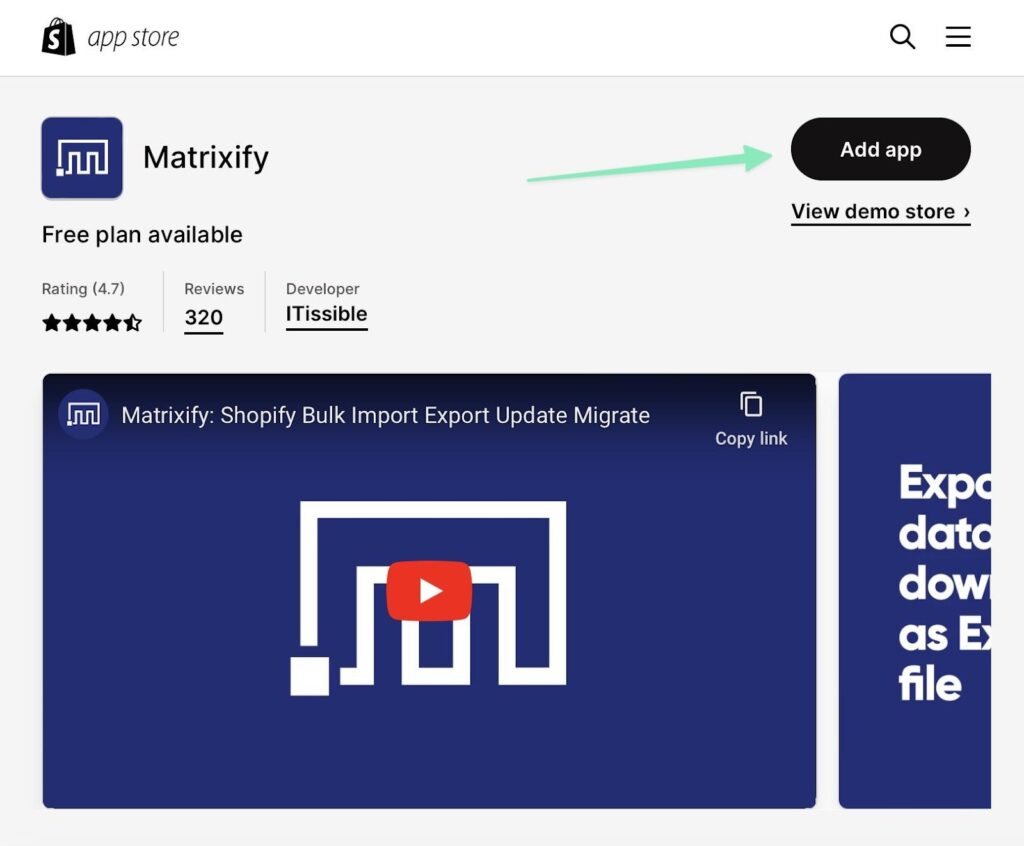
Back in Shopify, you should now see a Matrixify tab. This is under the Apps section. Open the Matrixify tab to migrate data via CSV files, or by importing with a site URL. You can try your Big Cartel URL but, in our experience, you’ll have the best results importing a CSV or Excel sheet.

Step 2: Export all desired site data from Big Cartel
Exporting data from Big Cartel is limited, but you do have the ability to pull information from two ecommerce related categories.
For each category, however, you must export a separate CSV file. For instance, products and orders should have their own CSV files.
Here’s what you can export from Big Cartel:
- Products
- Orders
Let’s start with product data. There’s no button to export product data from Big Cartel, so you must convert your frontend Product page into a JSON file. That’s easy enough. Simply go to this URL in your browser: example.bigcartel.com/product.json, but replace “example” with the actual domain name of your store. This process simply adds the “.json” tag onto your usual product gallery from Big Cartel.
That gives you a JSON text file within the browser.
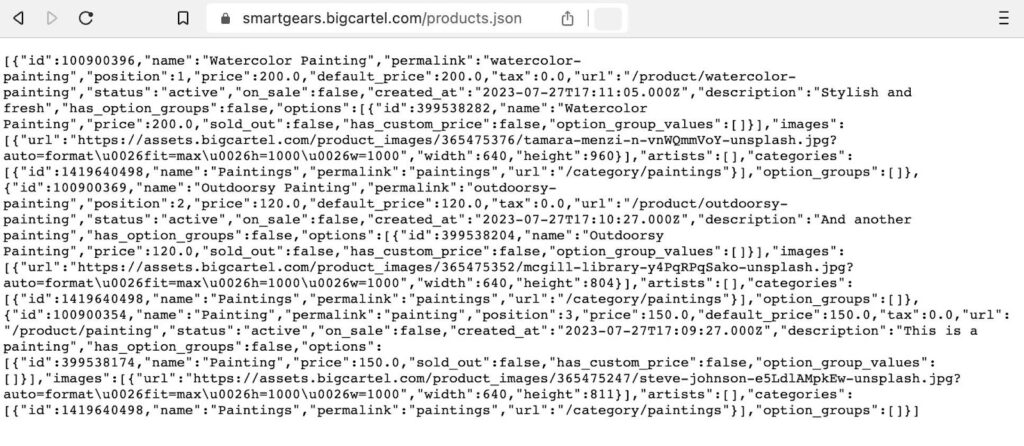
You can right-click on a white area of the page to “Save As…” Make sure nothing is highlighted on the page, or you won’t be able to download the file. There are often other options to save a file like this; most browsers have a Share This Page button (after which you’d save it to your computer).
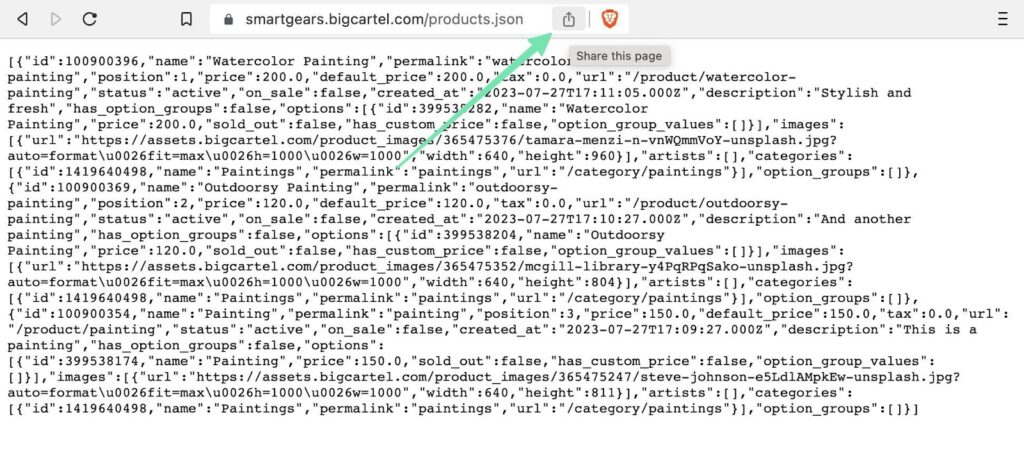
Save the .json file to your machine.
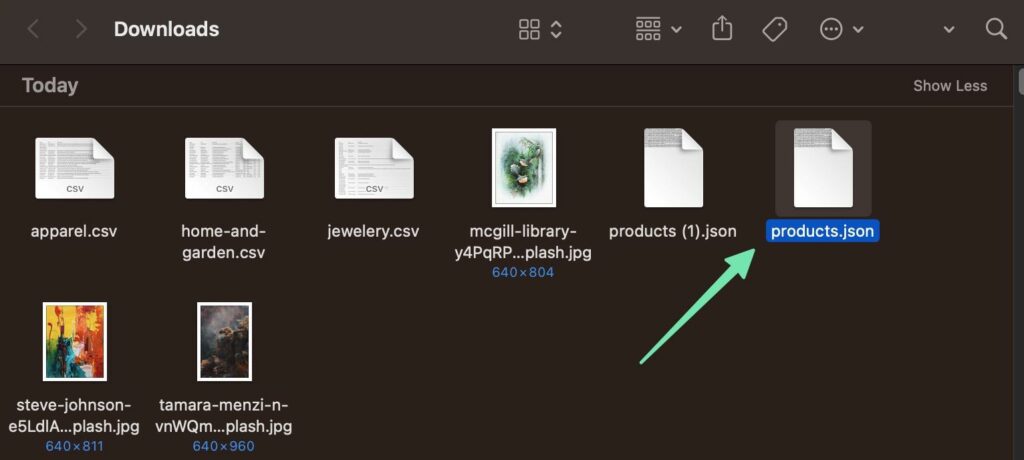
You must convert the .json file into a CSV file. Several free converters exist online. The data.page JSON to CSV Converter works well.
Upload the saved JSON file and click the Download button. This downloads the converted CSV file with your product data intact.
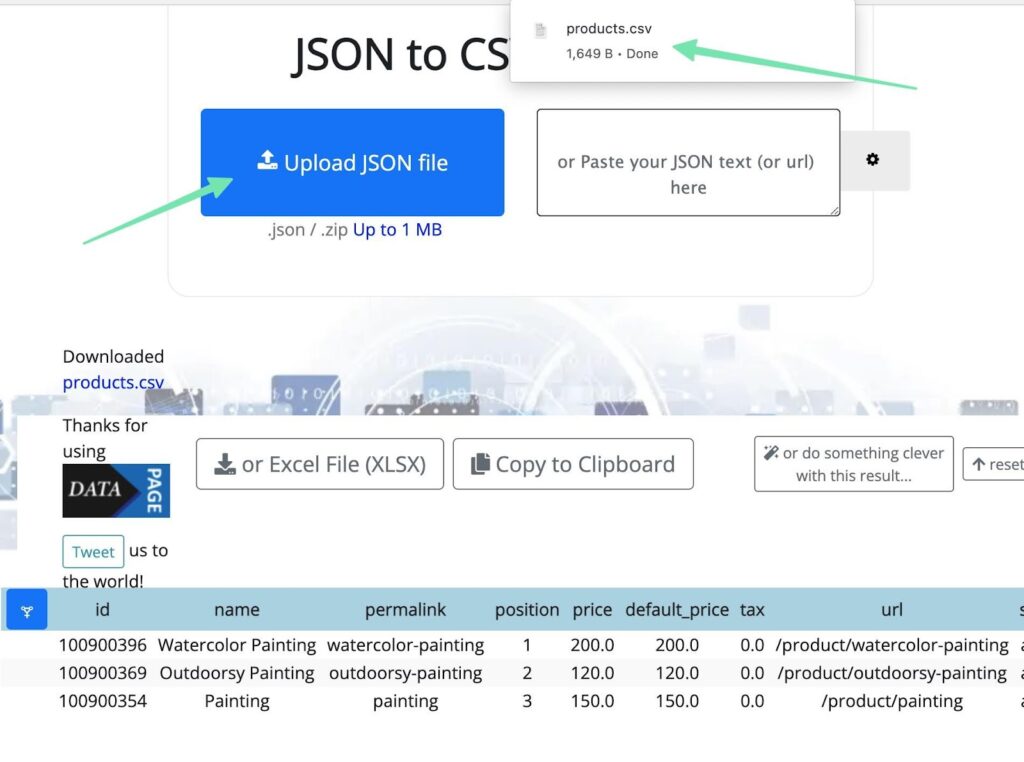
Step 3: Format the sheets for Matrixify
Matrixify has its own file formatting standards, so you want to match that as best as possible.
The Import To Shopify page from Matrixify offers formatting requirements to ensure your import works.
Here are the main rules/tips to keep in mind:
- Make sure the import files include the import entity within the file name. For instance, “products” should be in the file name of a CSV for a product import. The same goes for orders, where you should have “orders” in the CSV file name.
- Demo files are listed here. Choose a file based on what you plan on importing: products or orders.
- Matrixify supports Excel, CSV, or Google Sheets formats.
Here’s what the demo file for products looks like:
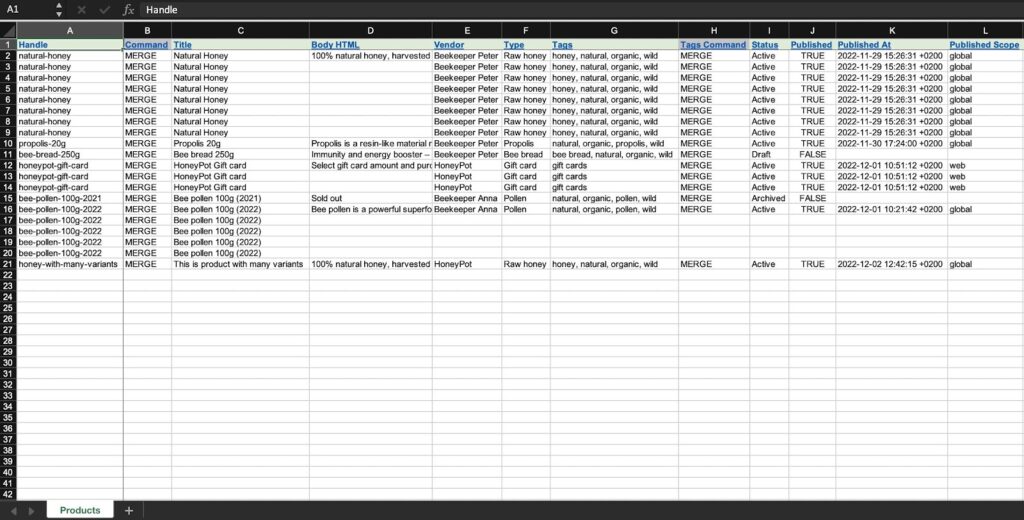
A CSV from Big Cartel (converted from JSON) looks a little different:

So, you should absolutely change column headers to match what Matrixify wants (like changing “name” to “title,” and “permalink” to “handle.”) Another method is to take the Matrixify templates and simply copy and paste the Big Cartel CSV data into that, ensuring you have all the right column headers.
Note: The order of the columns doesn’t matter.
Step 4: Import each data sheet into Matrixify
Now it’s time to import the CSV files to Shopify. Go to the Shopify Admin dashboard, and click on Apps > Matrixify. Under the Import section, click Add File.

Upload the CSV file you saved from before (the one converted from a JSON). The Matrixify app completes the import (it takes longer with more products). It then delivers a report that explains the number of products to import, ignored columns, and any errors.
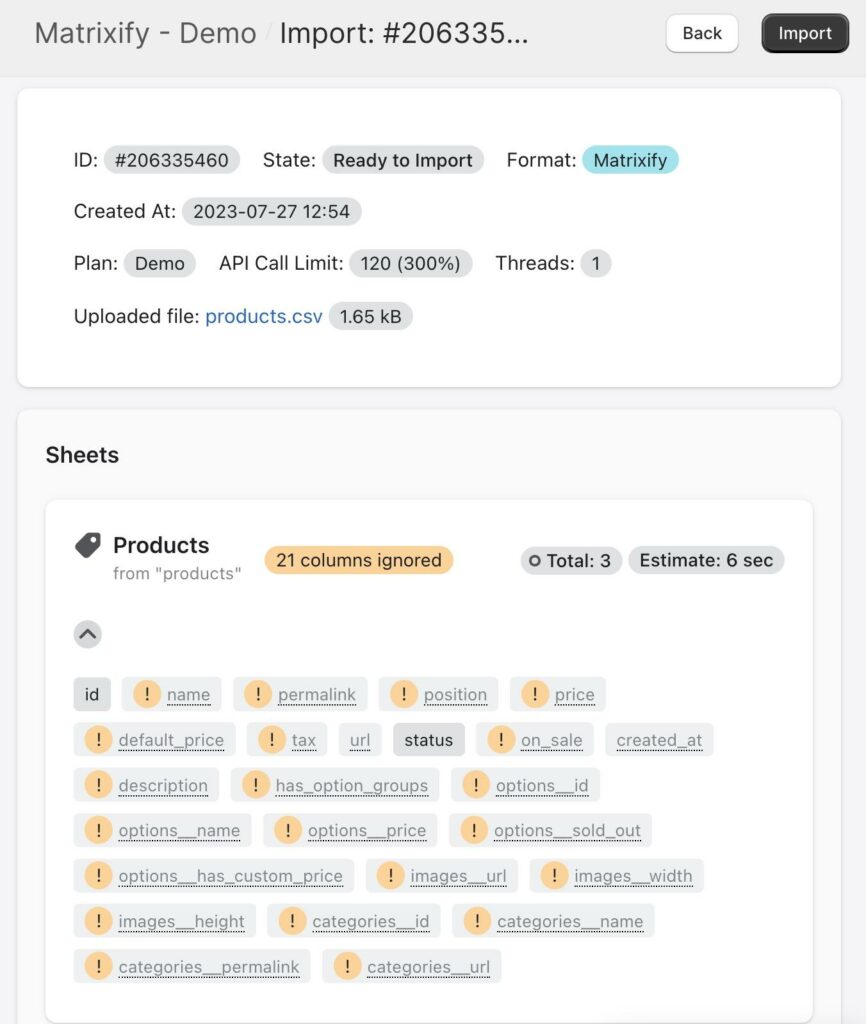
If you have critical errors, use Matrixify’s tips to fix them. To proceed with the import, click Import.
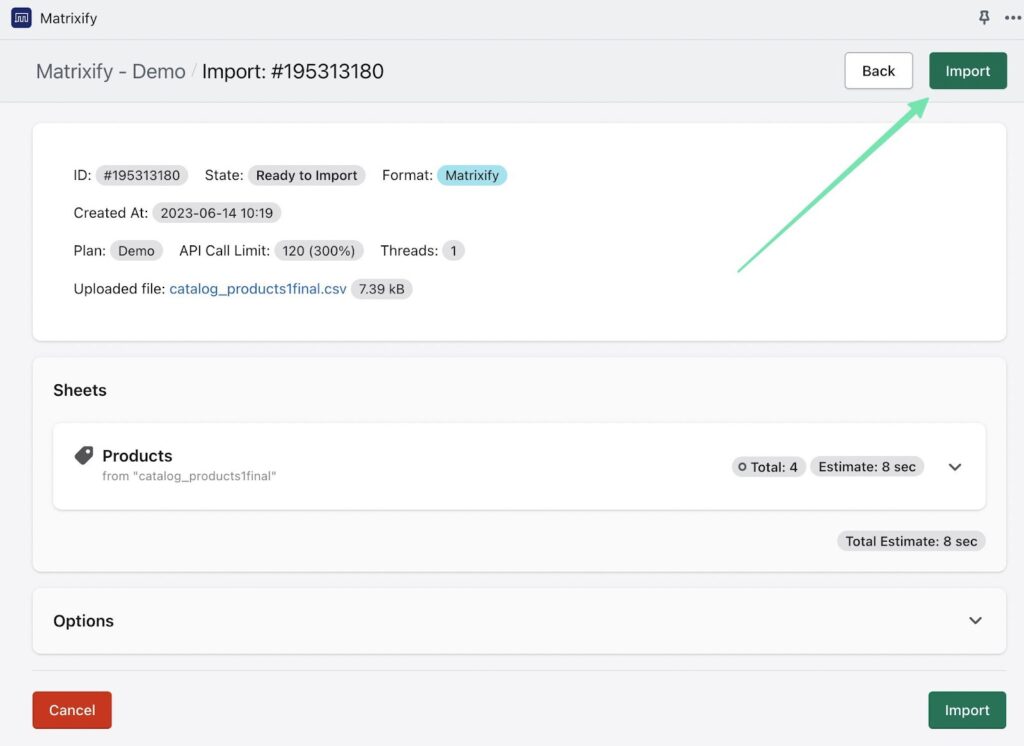
It’s common to see errors when the import is done.
That’s simply because not all Big Cartel columns align with what Shopify has. But the best way to avoid errors is to transfer all Big Cartel CSV data into a Matrixify Product CSV/Excel template.
Matrixify lists the number of new products, and those that failed.

To see the products in Shopify, go to the Products page in the dashboard. This provides a list of all items migrated from Big Cartel.

Feel free to open a product page to see everything that moved over, like images, product categories, variants, and pricing.
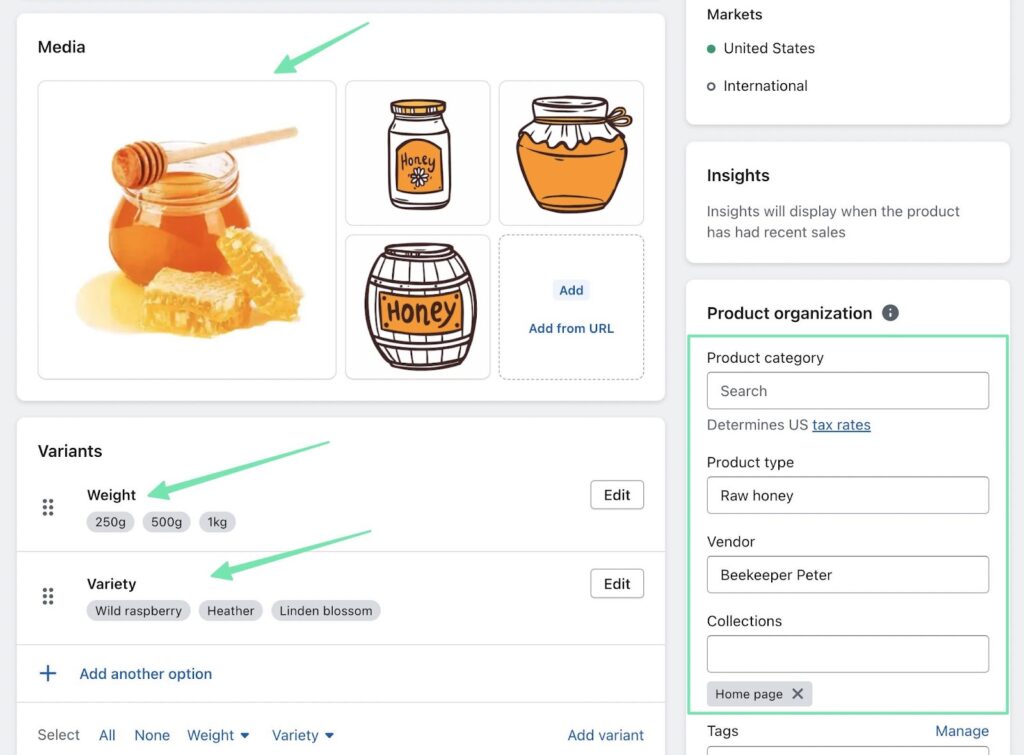
For each entity you wish to migrate from Big Cartel to Shopify, you will need to perform a separate import process.
Keep in mind, the only other entity available for export from Big Cartel is Orders.
To download a file of all orders, open Big Cartel, then go to the Orders tab. Choose Unshipped or Shipped, depending on what you want to migrate.
Select the Ellipses (three dots) icon, then click on Download CSV.

For orders, you must still move the CSV data into an appropriate Matrixify CSV/Excel template. Here’s the template for orders.
Other than that, no other data is extractable from Big Cartel.
You must manually copy additional data from the dashboard and paste or type it into Shopify. Other elements will require starting from scratch in Shopify, especially the overall website design.
How to manually migrate from Big Cartel to Shopify (without an app)
Since a considerable part of the migration process, especially website redesign, typically requires manual work, you may decide to migrate all your data manually.
If this is your preference, follow these steps to effectively migrate your website from Big Cartel to Shopify.
Like using an app, migrating from Big Cartel to Shopify involves exporting various sheets from Big Cartel and importing them into Shopify. Here's an example of how you can manually import products directly into Shopify:
Step 1: Export required data sheets from Big Cartel
To download BigCartel products, go to example.bigcartel.com/products.json in your browser—except replace the “example” part with your store name.
Save this file to your computer. Use the data.page JSON to CSV Converter to switch the JSON file to a CSV. Save that CSV to your machine.
Step 2: Format the CSV file to import it to Shopify
To facilitate a seamless data import into Shopify, utilize this provided sample product import CSV file. We recommend saving the demo product file and then copying the relevant data from the exported file you obtained from Big Cartel. The sample CSV file looks like this:

The CSV from Big Cartel (converted from a JSON) looks like this:

To ensure a smooth transfer of data, copy the relevant column data from your Big Cartel sheet into the corresponding columns of the Shopify sample CSV.
Make sure, however, to retain the column headers provided in the sample CSV. By doing so, you will maintain the required column headers for Shopify while transferring all the data from your Big Cartel sheet into the appropriate columns. It's important to note that the order of the columns does not matter when importing into Shopify.
Note: You’re more than welcome to simply leave the Big Cartel CSV as-is. During our tests, Shopify actually did a decent job of mapping Big Cartel fields to its own fields.
Step 3: Import the files into Shopify
In Shopify, go to Products > Import.

Click the Add File button. Find the right file on your computer, then select Upload and Preview. Check the field mapping to see if it looks okay. Finally, click the Import Products button.
To begin, click on the Add File button and select the desired file from your computer. Then, pick Upload and click Continue to proceed. Take a moment to review the import preview and ensure that everything appears correct. Finally, click on the Import Products button to finalize the process.

Some imports take a while, depending on how many products or orders you bring in from Big Cartel. After the wait, go to the Products tab in Shopify to see the newly imported items from Big Cartel.

The manual method actually performed stronger in some areas, like for moving pictures from Big Cartel to Shopify, or even mapping the pricing correctly.
When you’re done with products, you can also migrate orders from Big Cartel to Shopify.
FAQs on migrating from Big Cartel to Shopify
This section is dedicated to addressing any pressing questions you may have regarding the migration process from Big Cartel to Shopify.
We have provided detailed answers to frequently asked questions to ensure that you have all the information you need and can navigate the migration smoothly without encountering any obstacles.
Why should I consider migrating from Big Cartel to Shopify?
Even though Big Cartel is useful for many people/brands, there are some reasons you might want to move to Shopify:
- Features like more payment options, or international selling
- Scalability for large or fast-growing businesses
- A larger app store
- 24/7 support
- Multichannel selling
- More advanced design and customization
Can I migrate my entire website from Big Cartel to Shopify?
You can migrate:
- Products
- Orders
During the migration process from Big Cartel to Shopify, it's crucial to keep in mind that certain elements, including specific SEO configurations and most design elements, cannot be directly transferred.
As a result, you will need to manually re-upload your logo and customize the homepage to align with your preferences.
Can I back up my Big Cartel site before migrating?
Big Cartel doesn’t have a full site backup that we’re aware of. In fact, the only way to back up any type of data is by using the methods outlined above (the same way you’ve exported data for migrating products and orders).
To ensure a smooth transition, we suggest keeping your Big Cartel account open until you have fully migrated and published your new Shopify website.
It's important to complete the migration process and confirm that everything is functioning as desired before closing or deleting your Big Cartel account. This approach helps avoid any potential disruptions or loss of data during the migration process.
How can I select the appropriate Shopify plan for my business?
Use our guide on Shopify pricing plans for detailed information.
When choosing a pricing plan for your business, it's essential to find the right balance between necessary features and cost-effectiveness.
Take the time to carefully review each pricing plan to determine which one meets all your feature requirements while staying within your budget. Here are our recommendations:
- Shopify Starter Plan: This plan is ideal for social media influencers and content creators who want to sell a limited number of items through their platforms. It costs $5 per month.
- Basic Shopify Plan: Designed for small businesses and individuals, this plan allows you to sell an unlimited number of products through an online store. It includes features such as checkout, payment processing, reports, and shipping discounts. The cost is $29 per month.
- Shopify Plan: This plan is suitable for small to mid-sized brands that require enhanced ecommerce reporting capabilities or additional staff accounts. It is priced at $79 per month.
- Advanced Plan: Best suited for medium to large businesses, this plan offers custom reporting options and the lowest possible credit card processing fees through Shopify. It also provides more staff accounts. The cost is $299 per month.
By considering these recommendations, you can select the pricing plan that best aligns with your business needs and budgetary constraints.
Can I replicate my Big Cartel store design in Shopify?
While it is not possible to create an exact replica, you can customize the design of your new Shopify store to closely match your Big Cartel website. You can explore Shopify themes that resemble the design of your current site and adjust the primary and secondary colors to match.
Uploading your logo, styling your pages and blog posts similarly, and utilizing custom code for unique design elements from your previous site are also options.
However, it's important to note that there is no instant “copy and paste” feature to transfer a site design from Big Cartel to Shopify. Manual adjustments and customization will be necessary to achieve your desired design on the Shopify platform.
What impact does the migration have on my SEO rankings?
The impact of migrating from Big Cartel to Shopify on your SEO rankings depends on various factors. While your domain name plays a major role in SEO, the migration process itself can have implications. Here are some key considerations:
- Execution: A poorly executed migration, leading to broken links, missing images, or improperly formatted content, can potentially harm your SEO rankings. It is crucial to ensure a smooth and error-free transfer of all elements.
- User-Friendliness: The new design of your Shopify store may impact user-friendliness, which can indirectly affect search rankings. If users and search engines perceive the new design negatively, it could potentially impact your SEO performance.
- Improved Optimization: On the positive side, a well-executed redesign on Shopify can result in a simpler, more modern interface with improved mobile optimization. This can have a positive impact on your SEO rankings, as search engines tend to favor mobile-friendly websites.
It's essential to approach the migration process meticulously. By ensuring a seamless transfer of all elements, optimizing the new design for user-friendliness, and focusing on mobile optimization, you can maintain or even improve your SEO rankings with the transition to Shopify.
Our conclusion on how to migrate from Big Cartel to Shopify
To embark on the migration journey from Big Cartel to Shopify, you'll need to export your site data from Big Cartel and transfer it to Shopify.
This can be done manually or with the assistance of an app. It's advisable to search for a Shopify theme that closely resembles the design of your Big Cartel site and then customize it by incorporating the same colors, logo, and unique stylings.
Before initiating the migration process, it's wise to create a backup of your site to prevent any potential data loss. Additionally, refrain from deleting your old site until you are completely satisfied with the results and ready to launch your new Shopify store.
If you have successfully completed the migration from Big Cartel to Shopify, we encourage you to share your valuable tips or pose any questions you may have in the comments section below!
Your insights and experiences can greatly benefit others undergoing a similar transition.




Comments 0 Responses